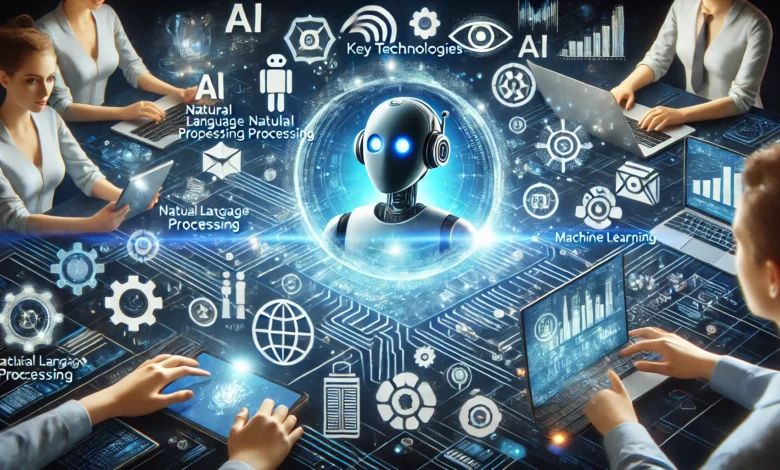Chatbot Key Technology: Unlocking the Power of Conversational AI

In the rapidly evolving world of artificial intelligence (AI), chatbot key tech have emerged as one of the most popular and powerful tools. From customer service to personal assistants and even mental health support, chatbots are increasingly becoming a part of our daily lives. But what makes these intelligent systems tick? What are the key technologies that allow chatbot key tech to understand, converse, and respond to human interactions? In this article, we’ll explore the underlying technologies that power chatbots and how they work together to create the seamless and often impressive experiences users enjoy today. chatbot key tech
What is a chatbot key tech?
Before diving into the technical details, it’s important to understand what a chatbot is. A chatbot is a software application designed to simulate human conversation. These digital assistants are powered by AI and natural language processing (NLP) and can engage in text-based or voice-based interactions with users. Chatbots are programmed to respond to queries, complete tasks, and provide information, often without the need for human intervention. chatbot key tech
Chatbots are used across many industries, from e-commerce platforms where they assist in shopping and troubleshooting, to healthcare systems where they provide advice or emotional support. Their versatility and efficiency have made them invaluable tools in modern communication and service delivery. chatbot key tech
Key Technologies Behind chatbot key tech
At the core of every chatbot is a suite of powerful technologies. These technologies enable chatbots to comprehend language, interpret user input, and generate meaningful responses. Let’s break down the key technologies that make chatbots so effective. chatbot key tech
Natural Language Processing (NLP)

Natural Language Processing, or NLP, is arguably the most critical technology powering chatbots. It’s the branch of AI that focuses on enabling computers to understand, interpret, and generate human language. NLP allows chatbots to decipher the meaning behind words and phrases, even when they’re used in various contexts. chatbot key tech
NLP involves several sub-technologies and techniques. Some of the most important ones include:
- Tokenization: This process breaks down sentences into individual words or tokens, making it easier for the chatbot to understand the components of a sentence.
- Part-of-Speech Tagging (POS): POS tagging assigns a specific role to each word in a sentence (e.g., noun, verb, adjective). This helps the chatbot understand how the words relate to each other.
- Named Entity Recognition (NER): NER identifies and categorizes key elements within text, such as names, dates, locations, and more, which helps the chatbot understand the context of a conversation.
- Sentiment Analysis: This technology enables chatbots to detect the emotional tone of a message, such as whether the user is happy, frustrated, or angry. Understanding sentiment helps chatbots respond more appropriately.
- Parsing: Parsing involves analyzing sentence structures to identify how words are related. It helps chatbots understand the grammatical structure of a sentence and produce more accurate responses.
Through these processes, NLP empowers chatbots to understand complex language, handle ambiguity, and even deal with slang or regional dialects. Without NLP, a chatbot would struggle to make sense of the diverse and dynamic nature of human language. chatbot key tech
Machine Learning (ML)
Machine Learning (ML) is another fundamental technology used in chatbot development. ML refers to the ability of a system to learn from data and improve its performance over time without explicit programming. In the context of chatbots, ML allows them to learn from previous interactions and adapt to better meet the needs of users. chatbot key tech
There are several ways in which ML enhances chatbot functionality:
- Supervised Learning: In supervised learning, chatbots are trained on labeled data (e.g., pairs of questions and answers). By analyzing this data, chatbots learn to map questions to appropriate responses. The more data a chatbot is trained on, the more accurate it becomes.
- Unsupervised Learning: In unsupervised learning, chatbots are trained on unlabeled data and must find patterns and structure within the information. This type of learning is useful for chatbots that need to handle unexpected queries or new topics.
- Reinforcement Learning: Reinforcement learning is a technique where chatbots are rewarded for making correct decisions and penalized for making mistakes. Over time, the chatbot refines its decision-making process to improve its responses. chatbot key tech
ML enables chatbots to continuously improve by learning from past conversations and user feedback, allowing them to handle more complex queries and offer more personalized experiences. chatbot key tech
Deep Learning
Deep learning, a subset of machine learning, uses neural networks with many layers to analyze large amounts of data and make decisions. Deep learning is particularly powerful for tasks such as image recognition, speech recognition, and, of course, natural language understanding. chatbot key tech
In the context of chatbots, deep learning allows them to understand complex linguistic patterns and generate more natural-sounding responses. By using large datasets, deep learning models can improve their language generation capabilities and even mimic human-like conversations. Some advanced chatbots, such as those based on GPT (Generative Pretrained Transformer) models, rely heavily on deep learning to generate contextually relevant and coherent dialogue. chatbot key tech
Speech Recognition and Synthesis
While many chatbots operate through text-based interfaces, voice-enabled chatbots are becoming increasingly popular, especially with the rise of virtual assistants like Siri, Alexa, and Google Assistant. For these chatbots to work effectively, they need speech recognition and synthesis technologies. chatbot key tech
Speech Recognition converts spoken language into written text. This allows voice-activated chatbots to process and understand verbal commands from users. Speech recognition systems use algorithms to break down sound waves, identify words, and transcribe them into text that the chatbot can understand. chatbot key tech
Speech Synthesis (or text-to-speech) is the process of converting text responses into spoken words. This is how virtual assistants can “speak” back to users, delivering their answers or carrying out tasks verbally. Advances in speech synthesis have made these systems sound more natural, with human-like inflections and tone. chatbot key tech
By combining these technologies, voice-based chatbots can engage in fluid, real-time conversations with users, enhancing accessibility and convenience. chatbot key tech
Knowledge Bases and Databases
A key part of any chatbot’s ability to answer questions is its access to relevant information. This is where knowledge bases and databases come into play. These structured repositories contain data that the chatbot can query to provide accurate responses. chatbot key tech
A knowledge base is a collection of organized information, such as frequently asked questions (FAQs), manuals, troubleshooting guides, and more. Chatbots can reference these knowledge bases to find relevant answers to user queries. For example, a customer service chatbot might pull from a knowledge base of product manuals to help users solve technical issues.
Databases, on the other hand, store more extensive data, including customer information, order histories, and other business-specific information. Chatbots that integrate with databases can retrieve personalized information for users, making interactions more relevant and efficient.
Contextual Understanding
Context is crucial in any conversation. Without it, a chatbot can easily misinterpret a user’s intentions. Contextual understanding is the ability of a chatbot to remember key details from previous interactions and use this information to guide the conversation.
For example, if a user asks a chatbot to book a flight, it’s important for the chatbot to remember the destination, preferred travel dates, and any other preferences that the user has provided. Many chatbots use contextual memory to store this information and refer back to it as needed, ensuring that the interaction remains smooth and personalized.
Contextual understanding also involves detecting the flow of conversation. A user might ask a chatbot several questions in a single exchange, and the chatbot must be able to keep track of each part of the conversation and respond appropriately.
Integration with Third-Party Systems
For chatbots to be truly useful, they need to be able to interact with other systems. This is where integrations come into play. Many chatbots are designed to connect with third-party applications, services, and platforms to extend their functionality.
For instance, a chatbot integrated with an e-commerce platform can help users browse products, check stock levels, and make purchases directly through the chatbot interface. A chatbot connected to a CRM (Customer Relationship Management) system can pull up customer data to provide personalized recommendations or support.
Integrations are key to making chatbots versatile and effective in real-world applications. Whether it’s accessing a calendar to schedule appointments, querying a database for order details, or interfacing with a payment gateway, integrations give chatbots the ability to perform a wide range of tasks.
Ethics and Privacy Considerations
As chatbots become more sophisticated and integrated into everyday life, ethical considerations and privacy concerns are becoming increasingly important. Chatbots that handle sensitive data, such as personal information or payment details, must adhere to strict privacy standards to protect users’ data.
One key issue is ensuring that chatbots are transparent about data collection. Users should be aware of what data is being gathered, how it will be used, and whether it will be shared with third parties. Additionally, AI systems, including chatbots, must avoid biases in decision-making. This requires careful training on diverse datasets to ensure that the chatbot is fair and inclusive in its responses.
Furthermore, regulations like GDPR (General Data Protection Regulation) have set strict guidelines for how user data should be handled. Businesses deploying chatbots must ensure they comply with these regulations to avoid legal issues and protect user trust.
The Future of Chatbots: Emerging Technologies
The world of chatbot technology is constantly evolving. Some of the emerging trends and technologies that are likely to shape the future of chatbots include:
- Emotion AI: This technology aims to allow chatbots to recognize and respond to users’ emotions, creating more empathetic and human-like interactions.
- Multimodal Interfaces: Chatbots will increasingly be able to handle both text and voice, and even interpret images and videos, creating more immersive and dynamic interactions.
- AI-Generated Content: As deep learning models become more advanced, chatbots will be able to generate more sophisticated and personalized content, including blogs, articles, and product descriptions.
- Autonomous Chatbots: With improvements in AI and machine learning, chatbots may eventually become fully autonomous, capable of handling more complex tasks with minimal human intervention.
The possibilities are vast, and as these technologies mature, chatbots will continue to transform the way we interact with digital systems.
Conclusion
Chatbots are more than just automated response systems; they are powered by a combination of cutting-edge technologies that enable them to engage in meaningful, personalized, and intelligent conversations. From Natural Language Processing and Machine Learning to deep learning, speech recognition, and contextual understanding, each component plays a crucial role in making chatbots effective and efficient.
As AI continues to advance, the potential applications for chatbots will only expand. Businesses will rely on them to improve customer experiences, streamline operations, and enhance service delivery. And for users, chatbots will become an increasingly seamless part of daily life, helping with everything from shopping to entertainment to problem-solving.
Understanding the key technologies behind chatbots not only helps us appreciate their complexity but also gives us a glimpse into the future of AI-powered communication. As these technologies continue to evolve, the next generation of chatbots will undoubtedly be smarter, more intuitive, and even more capable of understanding and responding to the nuances of human conversation.



